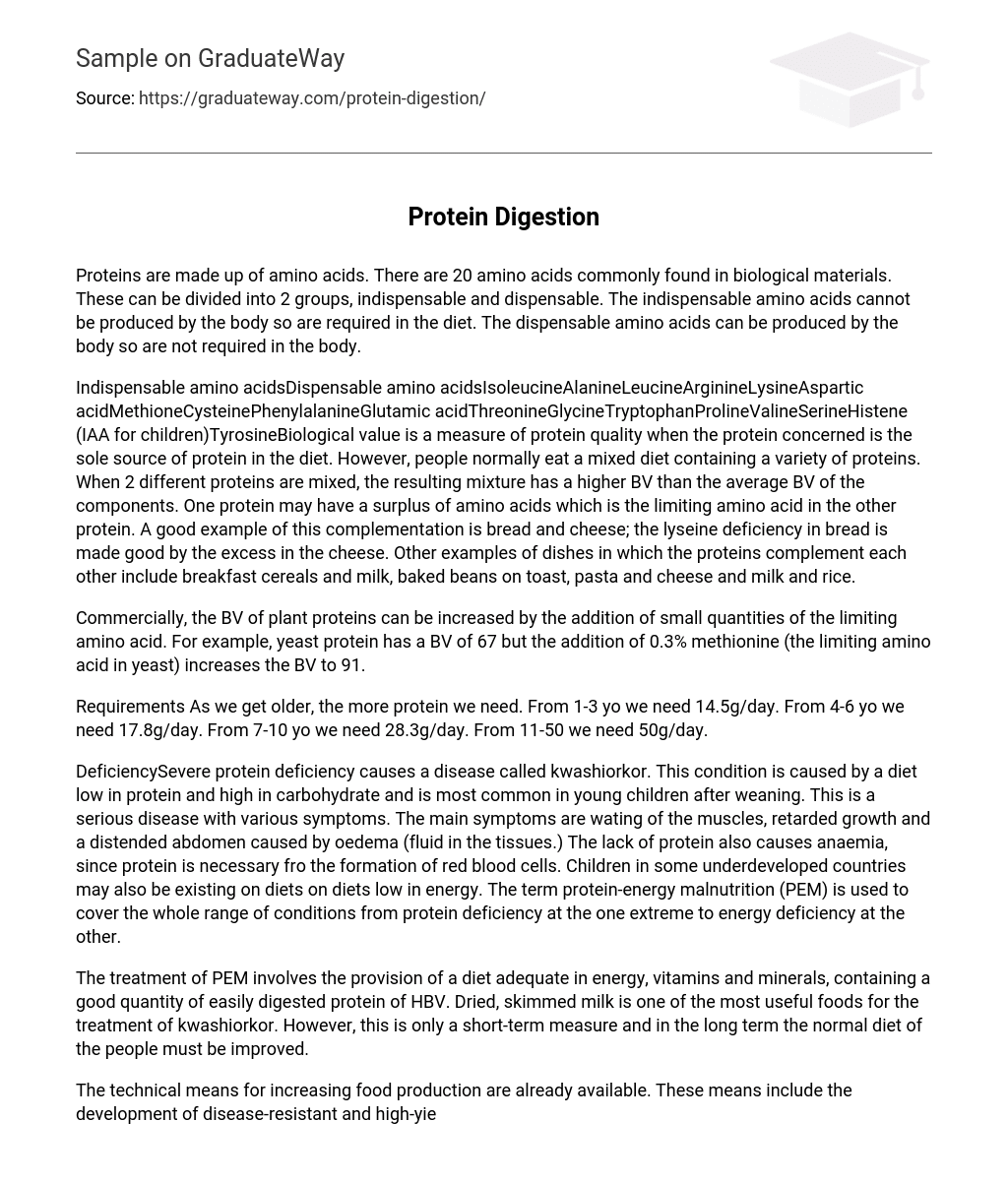Proteins are made up of amino acids. There are 20 amino acids commonly found in biological materials. These can be divided into 2 groups, indispensable and dispensable. The indispensable amino acids cannot be produced by the body so are required in the diet. The dispensable amino acids can be produced by the body so are not required in the body.
Indispensable amino acidsDispensable amino acidsIsoleucineAlanineLeucineArginineLysineAspartic acidMethioneCysteinePhenylalanineGlutamic acidThreonineGlycineTryptophanProlineValineSerineHistene (IAA for children)TyrosineBiological value is a measure of protein quality when the protein concerned is the sole source of protein in the diet. However, people normally eat a mixed diet containing a variety of proteins. When 2 different proteins are mixed, the resulting mixture has a higher BV than the average BV of the components. One protein may have a surplus of amino acids which is the limiting amino acid in the other protein. A good example of this complementation is bread and cheese; the lyseine deficiency in bread is made good by the excess in the cheese. Other examples of dishes in which the proteins complement each other include breakfast cereals and milk, baked beans on toast, pasta and cheese and milk and rice.
Commercially, the BV of plant proteins can be increased by the addition of small quantities of the limiting amino acid. For example, yeast protein has a BV of 67 but the addition of 0.3% methionine (the limiting amino acid in yeast) increases the BV to 91.
Requirements As we get older, the more protein we need. From 1-3 yo we need 14.5g/day. From 4-6 yo we need 17.8g/day. From 7-10 yo we need 28.3g/day. From 11-50 we need 50g/day.
DeficiencySevere protein deficiency causes a disease called kwashiorkor. This condition is caused by a diet low in protein and high in carbohydrate and is most common in young children after weaning. This is a serious disease with various symptoms. The main symptoms are wating of the muscles, retarded growth and a distended abdomen caused by oedema (fluid in the tissues.) The lack of protein also causes anaemia, since protein is necessary fro the formation of red blood cells. Children in some underdeveloped countries may also be existing on diets on diets low in energy. The term protein-energy malnutrition (PEM) is used to cover the whole range of conditions from protein deficiency at the one extreme to energy deficiency at the other.
The treatment of PEM involves the provision of a diet adequate in energy, vitamins and minerals, containing a good quantity of easily digested protein of HBV. Dried, skimmed milk is one of the most useful foods for the treatment of kwashiorkor. However, this is only a short-term measure and in the long term the normal diet of the people must be improved.
The technical means for increasing food production are already available. These means include the development of disease-resistant and high-yielding crops, the use of chemical fertilisers and pesticides, irrigation of infertile land and the further development of fish farming. However, the main causes of food shortages and malnutrition are economic, political and social, rather than technical. The richer, industrialized countries have the purchasing power to take more than their share, while the poorer countries do not have the money to invest in their own agriculture or import sufficient food.
Production of animal protein is not an efficient method of obtaining protein since animals are not efficient at converting dietary protein into body protein. As little as 15% of the protein fed to an animal is actually converted into consumable protein such as meat, milk and eggs. It is therefore more economic to eat plant protein, rather than feed animals with cereals and protein concentrates and eat the animal products. One hectare of land used to graze cattle will provide enough beef to meet the protein requirement of one man for 300 days. If this hectare of land is used for the production of wheat, 3500 days protein supply can be produced, and if it is used for the cultivation of soya beans, 8000 days protein requirement can be supplied by the same area of land.





